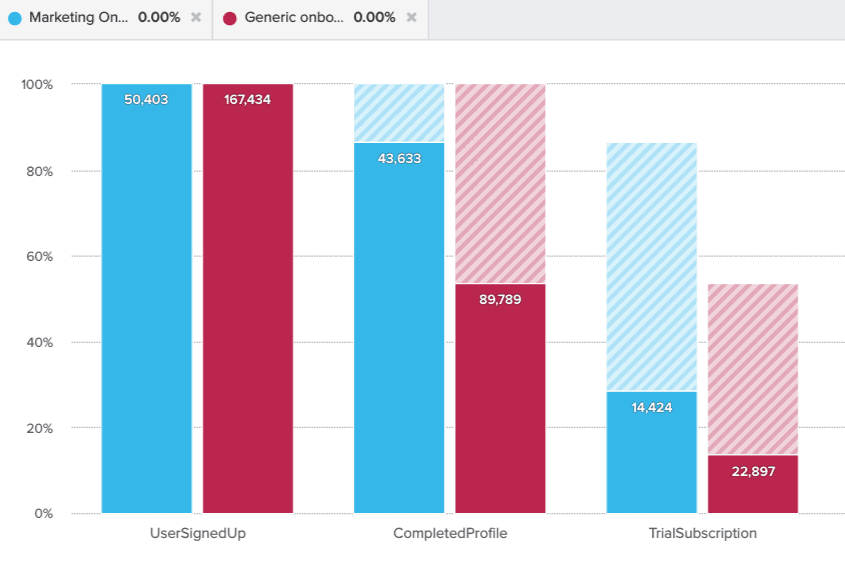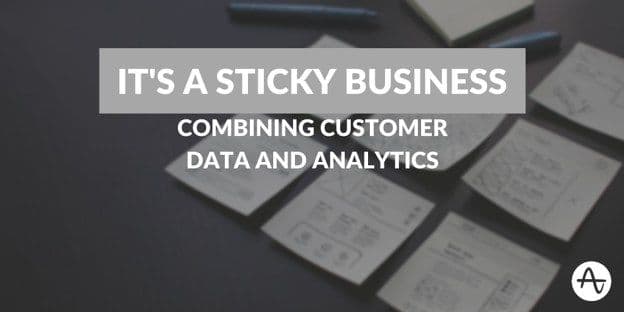It’s a Sticky Business: Combining Customer Data and Analytics
B2C apps have been using analytics to build better user experiences for years, but B2B analytics are a bit trickier.
Sticky products are just as important when you’re working with the enterprise. Organizational buyers have tons of options, which means that a tool that gets the job done and delights its users will have a huge advantage.
B2C apps have been using analytics to build better user experiences for years, but B2B analytics are a bit trickier. Good B2B analytics involves both segmenting your users based on the actions they take — behavioral cohorting — and segmenting them based on their unique context for using your app—where they work and what they do.
Increasing Growth With Segmentation
The problem with B2B analytics, historically, has been that the data you need to run good analytics is hard to get.
To understand why users drop out of onboarding and stop coming back to your product, you need to segment your users by the different variables that affect how they start using it in the first place. A FinTech growth marketer isn’t looking for the same kind of results as a sales lead at a major Fortune 500 company, and you shouldn’t treat them the same.
Using that customer data in your analytics will help you understand who is getting value out of your product, who needs help getting to that “Aha!” moment, and who your product should really be for.
One of the best ways to find that great data on your customers is sitting right in front of you—it’s their email address.
Fix Your Onboarding With Customer Cohorts
Every email your customers give you when they sign up is a doorway to more data.
Put an email address through a tool like Clearbit’s Enrichment API and you’ll get an extensive list of characteristics on that person:
- their company’s name
- their bio
- their role
- their job title
- their seniority at the company
By aggregating this kind of data on your users, you’ll be able to run powerful cohort analysis later on.

From this we learn what Martin at Auth0 does, where he stands at the company, and what his title is. If you’re building a B2B app, this kind of data is priceless for understanding user behavior.
You can send this data to Amplitude manually or you can use a service like Segment to help you. Once it’s in Amplitude, use it to create customized cohorts based on the specific characteristics you want to study.

Let’s say we create cohorts for all the different roles that our customers hold at their companies—marketing, sales, and software development—and test out customized onboarding flows based on each one.
Your standard “product tour” can be made a lot stronger when you know who you’re working with. Rather than force every user through the same onboarding experience, you can first let your users get a lay of the land and then use customized in-app triggers to get them, whoever they are, to the value of your app faster.
To see whether a new onboarding flow is successful, set up an A/B test:

In this example, our customized marketing onboarding flow (the blue bar) got users to complete their profiles at a 30% greater rate than those who got a generic flow (the red bar). About 20% more users went on to sign up for trial subscriptions. That’s a massive improvement and a great sign that customized onboarding can help bring users to their “Aha!” moments more quickly.
Who Are My Most Valuable Users?
Finding your most valuable users is one of the important things that a product manager has to do. Your definition of a valuable user has implications on how you seek feedback, prioritize features, and map out the future of your product.
Looking at cohort-separated numbers on how often people are using your app’s core features is a standard technique with B2C apps, but it doesn’t really work with the enterprise. Enterprise apps live and die on “jobs-to-be-done.” No one is editing their expense reports over and over because they’re having fun.
What behavioral cohorting allows you to do is look at the patterns of behavior that actually do correlate with long-term retention. It’s the counter-point to looking at onboarding flows—this is where you build, sustain, and safeguard the long-term value that users are getting out of your product.
Predicting User Retention With Compass
Testing out every pattern of behavior you think might be correlated with retention can be an extremely time-consuming process. Amplitude’s Compass tool expedites the process by giving you a quick, at-a-glance view of what behaviors best predict retention.
First, you need a Base Cohort — let’s take New Users. Then pick your target cohort — let’s use “Users who have been retained for two weeks.” As you grow and advance, your Base and Target are going to change, but these are standard places to start.
Enter your timespan, and Amplitude will run the numbers on which behavioral patterns best take users from your Base Cohort to your Target Cohort:

It seems that when users Add To Team more than two times a week in their first seven days, they stand a high likelihood of sticking around.
With the app’s general inflection point in mind, all of our customer data will go even further. Looking at the same Add To Team feature through three different cohorts of users, we can see whether certain groups of users are lifting overall retention up and which are bringing it down:

This graph says something crucial if you’re a product manager. While about 30% of salespeople and marketers are still using your app after two weeks, they’re joined by only 10% of developers. The impressive retention demonstrated by users who Add To Team two or more times was a total figure, whereas now we see that developers are dropping off in significantly greater numbers than marketers and salespeople.
Depending on your user base and your product, this could mean one of two basic things:
- Your real customers aren’t who you think they are: Maybe you were under the impression that developers would love your tool. That theory now has a huge dent in it, as developers use your app far less and are retained far worse than your customers who are salespeople and marketers.
- Your product doesn’t explain the value it holds for developers well enough: You’re losing half of your users after the first day, which is a good sign that your initial onboarding flow is worth a second look.
You’re either wasting money acquiring customers that are unfit for your app or you’re not investing enough into bringing them to its value. These are the awesome kinds of insights into inflection points and product strategy that you are only going to get by bringing together behavioral cohorting and customer analytics.
It’s A Sticky Business
The rise of SaaS has changed enterprise software forever.
Once uniformly obtuse and annoying to use, today’s business tools are smooth, elegant, user-friendly, and mobile.
Companies that recognize that and build for that are already winning. We already saw it happen with companies like Slack and Dropbox, whose ease of use and word-of-mouth virality overtook the enterprise world by storm simply by offering a better, stickier product experience.
Learn from them. Build a tool that doesn’t fit your users, and a company that does will drive you out of business one day.
Comments
Martin Gontovnikas: Now if I get spam I’ll blame you 😛 hahaha. Just kidding, thanks for the mention 💪 and great post BTW :).

Matt Sornson
Head of Growth Marketing, Clearbit
Matt is the Head of Growth Marketing at Clearbit.
More from Matt




